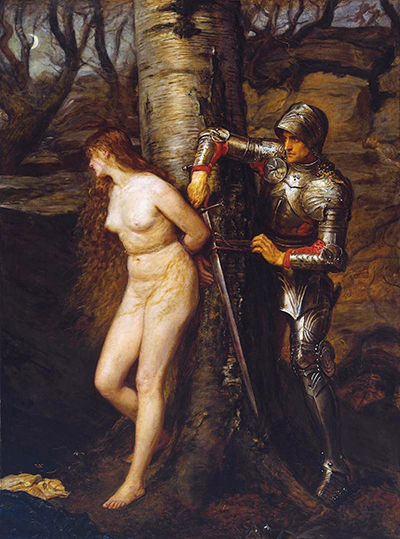The Knight Errant by Sir John Everett Millais is a large painting that features large life-size figures. The painting was accompanied by the text 'The order of Knights errant was instituted to protect widows and orphans, and to succour maidens in distress.'
This text was Millais’s own inscription that was presented in the Royal Academy in 1870. The painting depicts a moonlight scene where a knight dressed in armour, showcases medieval chivalry. The armour on the knight was an inspiration from the Tower of London. The knight is seen freeing a woman who is naked and tied to a tree. The Silver Birch tree was synonymous to the female gender in the 19th century, and it was often known as ‘Lady Birch’.
On the left side of the painting, the woman’s clothes on the ground are assumed to be removed by robbers, who are seen running away from the scene when you look at the top right part of the canvas. Looking closely on the right lower side of the painting, you will see the torso of a dead man, which might be an effect of the knight whose sword has blood. Millais made an attempt to paint a nude female for the first time in The Knight Errant. Later, more reviews flooded his way on how he represented the unclothed woman. The natural approach of Millais towards the story in the painting was compared to the continental practice of placing the nude in a classical setting.
The use of nudity is a model that was common in England at the time by artists like Albert Moore and Frederick Leighton. In fact, Millais was reviving the early-Victorian tradition that was favoured by Wiliam Etty who represented nudity. Millais admired William Etty’s technique and use of colour. Although Millais used the same techniques, his painting attracted a lot of critique because of the woman’s representation. Although Millais could be representing a social image with this painting, he might have been showcasing the simplicity of romance during Medieval times. The oil on canvas painting is currently on the Tate Gallery in London, UK.




